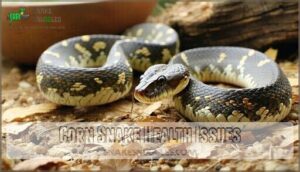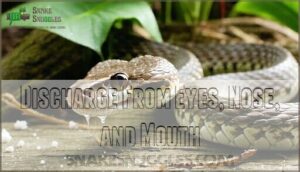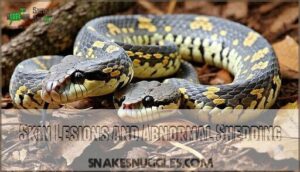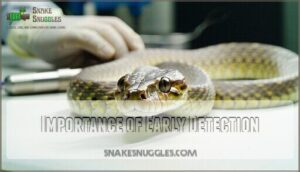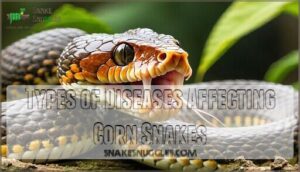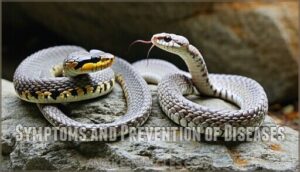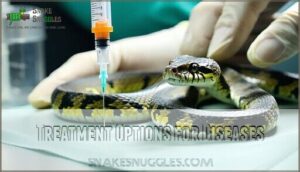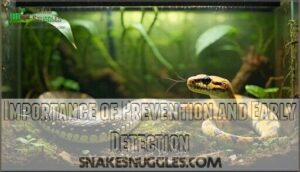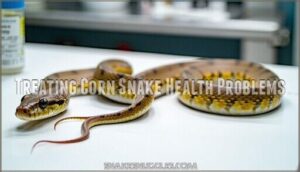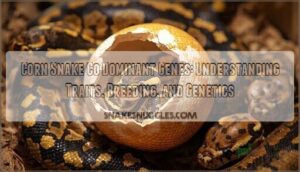This site is supported by our readers. We may earn a commission, at no cost to you, if you purchase through links.
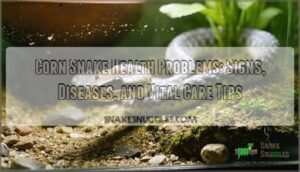
Common health problems include respiratory infections—watch for wheezing or excess mucus—and parasites, which might cause unusual weight loss or lethargy.
Issues with shedding, like retained skin, can signal improper humidity.
Sudden appetite changes or skin lesions could also be red flags.
Stress, poor diet, or an unclean enclosure often contribute to these problems.
Keep an eye on their weight, behavior, and appearance.
A well-set-up terrarium with proper temperature, humidity, and hygiene is key to prevention.
Spotting symptoms early is essential—you’d rather fix a small crack than let it turn into a canyon, and this is crucial for maintaining their overall health.
Table Of Contents
- Key Takeaways
- Corn Snake Health Issues
- Recognizing Sick Corn Snakes
- Corn Snake Diseases
- Maintaining Corn Snake Health
- Treating Corn Snake Health Problems
- Frequently Asked Questions (FAQs)
- Do corn snakes have health problems?
- What is the life expectancy of a corn snake?
- What is the biggest trouble with corn snakes?
- What diseases can corn snakes get?
- How is eating corn beneficial to the body?
- What diseases do corn snakes get?
- What are the symptoms of corn snake disease?
- How do you know if a corn snake is healthy?
- Are corn snakes venomous?
- What is toxic to corn snakes?
- Conclusion
Key Takeaways
- Keep an eye out for signs of illness like wheezing, unusual weight loss, or stuck shed, and address them quickly.
- Maintain proper humidity, temperature, and cleanliness in the terrarium to prevent common health issues like respiratory infections and shedding problems.
- Feed appropriately sized prey and ensure clean water daily to support proper nutrition and hydration.
- Regularly observe your snake’s behavior, weight, and shedding to catch potential problems early and avoid severe complications.
Corn Snake Health Issues
In terms of keeping your corn snake healthy, understanding common health problems is essential. Recognizing the early signs of illness can help you address issues before they become serious.
Common Health Problems in Corn Snakes
Corn snake illnesses can sneak up on you, so knowing common issues is essential.
Shedding problems, scale rot, and parasites are frequent concerns. Obesity prevention is key, as overfeeding causes health troubles.
Mouth rot, often linked to poor hygiene, can make your snake miserable. Regular checks help catch corn snake symptoms early, ensuring proper corn snake treatment and ongoing health, which is crucial for preventing shedding problems and obesity.
Signs of Illness and Stress
Spotting snake illness signs is key to good care. A sick corn snake might show lethargy signs, hide constantly, or skip meals.
Look out for:
- Breathing changes, like wheezing or open-mouth breathing
- Regurgitation signs after eating
- Scale abnormalities like redness or fluid-filled blisters
Catch these corn snake symptoms early to address potential snake disease symptoms effectively.
Factors Contributing to Health Issues
Poor snake health often stems from factors like genetic predisposition, environmental stressors, improper husbandry, and nutritional deficiencies.
Hygiene neglect can create risky conditions, allowing corn snake diseases to take hold. Overlooked stressors, like incorrect temperatures or humidity, can worsen snake health issues rapidly.
Regular check-ups can help with early disease detection and treatment. Consistent care, proper snake disease prevention, and maintaining the right environment help safeguard against snake diseases and keep your corn snake thriving with proper husbandry and environmental conditions.
Recognizing Sick Corn Snakes
Spotting early signs of illness in your corn snake is essential to ensuring its long-term health.
Spotting early signs of illness ensures your corn snake stays healthy, thriving, and well-cared for in the long term.
Learning to recognize changes like diminished appetite, unusual weight loss, or abnormal shedding helps you address potential problems before they worsen, and this is crucial for long-term health, as it involves recognize changes.
Changes in Appetite and Weight
Changes in appetite or weight often signal trouble with your corn snake’s health.
Keep an eye out for:
- Sudden anorexia – skipping multiple meals.
- Regurgitation causes – improper feeding or illness.
- Weight loss – visible spine or loose skin.
- Obesity signs – difficulty moving, excess body fat.
- Inconsistent feeding frequency – irregular habits.
Monitor weight regularly to confirm proper body condition.
Lethargy can also be a sign of underlying snake diseases.
Discharge From Eyes, Nose, and Mouth
Discharge from your corn snake’s eyes, nose, or mouth can signal issues like mouth rot or a respiratory infection.
Watch for thick mucus, bubbles, or a sour smell.
Common causes include poor hygiene or incorrect enclosure settings.
Seek veterinary care promptly for diagnosis and treatment options.
Preventative measures, like proper hygiene and maintaining the snake respiratory tract’s health, are essential.
Skin Lesions and Abnormal Shedding
Skin issues like blisters, scale rot, and stuck shed often point to poor humidity or dirty enclosures.
Corn snake shedding problems, like dysecdysis, may result from low humidity.
Dermatitis can cause lesions, while stuck shed increases infection risks.
Prevent scarring by maintaining proper humidity and cleanliness, and monitor shedding frequency closely to act quickly if your snake shows signs of skin infections or abnormalities.
Importance of Early Detection
Spotting subtle symptoms early is vital for your corn snake’s well-being.
Preventative care and rapid intervention can minimize damage, improve prognosis, and keep snake disease signs from escalating.
Regular snake health monitoring helps detect snake disease symptoms like lethargy or poor shedding.
Acting early guarantees effective snake veterinary care and reduces the risk of severe snake health problems in the long run, ensuring preventative care and rapid intervention are key to a good prognosis.
Corn Snake Diseases
Corn snakes can face a variety of diseases that affect their health and well-being, ranging from respiratory infections to parasitic infestations.
Respiratory infections and parasites are common threats—stay vigilant to keep your corn snake healthy and thriving.
Understanding the symptoms, treatments, and prevention strategies is essential to keeping your snake healthy and thriving.
Types of Diseases Affecting Corn Snakes
Let’s tackle common diseases in corn snakes. Stomatitis, parasitic infections, skin infections, respiratory issues, and septicemia are top concerns.
These issues can stem from poor handling, enclosure hygiene, or diet. Stay alert by watching for snake disease signs like lesions, pus, or lethargy.
- Stomatitis: Mouth rot causing swelling, mucus.
- Parasitic Infections: Mites, internal worms.
- Skin Infections: Blisters, dermatitis.
- Respiratory Issues: Wheezing, open-mouth breathing.
Symptoms and Prevention of Diseases
Spotting corn snake health problems early is key.
Look for appetite changes, unusual weight loss, or red belly scales—signs of illness.
Stress reduction methods, preventative habitat hygiene, and quarantining new arrivals are essential snake disease prevention strategies.
Balanced diets help avoid nutritional disease prevention issues.
Early symptom recognition allows for swift snake disease diagnosis, minimizing risks and ensuring timely management of potential health problems, which is crucial for the overall prevention of diseases.
Treatment Options for Diseases
Treating snake diseases often involves antibiotic therapy or antifungal medications, depending on the issue.
Parasite control using deworming medications is key for infestations. Severe cases may need fluid therapy or even surgical intervention.
A proper snake disease diagnosis from a veterinary consultation guarantees effective treatment. Regular antibiotics can address infections, but consistent care is essential to supporting your corn snake’s recovery.
Annual checkups are indispensable for monitoring overall health to ensure the overall health and recovery of your snake.
Importance of Prevention and Early Detection
Catching issues early can save your corn snake.
Regular checkups, stress-reduction efforts, and clean, well-maintained environments help prevent diseases.
Follow these snake health tips:
- Proactive Husbandry: A clean setup and consistent care reduce problems.
- Quarantine Protocols: New snakes need isolation to avoid spreading illnesses.
- Observation: Daily attention to appetite, shedding, and activity spots warning signs.
Healthy snakes thrive with prevention!
Maintaining Corn Snake Health
Keeping your corn snake healthy means providing the right environment, heating, lighting, and humidity to match their natural needs.
Proper enclosure hygiene and attention to detail are essential to prevent common health issues and guarantee their well-being.
Providing the right conditions is crucial, and proper enclosure hygiene is key to preventing health issues.
Terrarium Setup and Decor
A well-designed terrarium boosts corn snake health. Use secure hiding places for comfort, add enrichment items like branches to mimic their natural habitat, and guarantee a smooth terrarium background to prevent injuries.
Substrate options include coconut husk or cypress mulch for humidity control. Maintain a temperature gradient for comfort. A thoughtfully arranged snake environment supports healthy reptile husbandry.
Many owners also purchase suitable terrarium shelters to further reduce stress.
| Feature | Purpose | Example Items | Care Tip |
|---|---|---|---|
| Hiding Places | Reduces stress | Caves, logs | Place on both cool and warm sides. |
| Substrate Options | Humidity control | Cypress, coconut husk | Avoid pine and cedar. |
| Enrichment Items | Encourages activity | Branches, vines | Secure items to prevent collapse. |
| Background | Prevents abrasions | Smooth materials | Guarantee no sharp edges. |
Heating and Lighting Requirements
Proper heating and lighting are vital for your corn snake’s health.
Maintain a gradient—85°F on the warm side, low 70s°F on the cool side.
Provide UV lighting for 8-12 hours daily to mimic natural sunlight.
Replace bulbs every 6 months to guarantee effectiveness.
Proper lighting can be achieved with specialized reptile products.
- Use a basking lamp for temperature regulation.
- Monitor night temperatures carefully.
- Guarantee the thermal gradient is consistent.
Humidity and Water Requirements
Maintaining proper humidity levels is critical for your corn snake’s health.
Aim for 40-60% humidity, increasing to 70% during shedding humidity periods.
Use a water bowl size fitting their enclosure for snake hydration, and monitor levels with a hygrometer.
Many owners purchase a hygrometer to accurately measure humidity.
Misting frequency depends on humidity management needs—avoid overdoing it to prevent excess moisture.
Dehydration signs require immediate adjustment.
Importance of Proper Enclosure Hygiene
A clean setup keeps your corn snake healthy and happy.
Waste removal is non-negotiable—spot clean often and disinfect thoroughly with proper protocols monthly.
Pick substrates wisely to aid shedding while preventing infections.
Snake housing needs regular care, as dirty enclosures encourage disease spread.
Proper snake husbandry helps prevent illness.
Good hygiene protects against snake disease management challenges, making your care routine a lifesaver for your scaly friend, ensuring proper care and good hygiene.
Treating Corn Snake Health Problems
When your corn snake shows signs of illness, knowing how to respond quickly can make all the difference.
Timely veterinary care, proper treatment, and consistent attention to their needs are essential for their recovery and long-term health.
When to Call a Vet
If your corn snake shows snake illness signs like severe lethargy, breathing trouble, or skin lesions, it’s time for snake emergency care.
Unsure symptoms or cost concerns? A corn snake vet helps with preventative care and treatment.
Always consult a reptile veterinarian for unusual behaviors—it’s better to act early than face worse expenses or risks later, which is a key part of reptile care.
Treatment Options for Common Health Issues
Treating common corn snake health issues often involves specific, effective measures:
- Antibiotic Therapy: Use antibiotics prescribed by a vet for conditions like corn snake mouth rot and respiratory infections.
- Parasite Control: Treat parasites with dewormers or topical solutions under professional guidance.
- Wound Management and Supportive Care: For scale rot, clean wounds and adjust humidity. Severe cases may need surgical intervention.
Importance of Proper Care and Nutrition
You’ve got to stay on top of your corn snake’s care—it’s key to their health.
Balanced snake nutrition prevents obesity risks, while proper hydration supports shedding problems. Stick to preventative care, feeding appropriately-sized prey, and avoiding overfeeding to match your snake’s metabolism.
A clean, well-maintained terrarium also matters for their overall wellbeing.
| Aspect | Do | Don’t |
|---|---|---|
| Diet | Use frozen/thawed prey | Feed prey too large |
| Hydration Importance | Provide clean water daily | Ignore dehydration signs |
| Shedding Problems | Increase humidity during shed | Handle during shedding |
| Preventative Care | Schedule annual vet visits | Skip regular health monitoring |
| Snake Nutrition | Follow feeding guidelines | Overfeed or underfeed |
Frequently Asked Questions (FAQs)
Do corn snakes have health problems?
Yes, they can.
Issues like stuck shed, respiratory infections, and gastrointestinal problems arise if their care isn’t spot-on.
Watch for symptoms like labored breathing, dull skin, or reduced appetite, and consult a vet when needed, to address issues like respiratory infections promptly.
What is the life expectancy of a corn snake?
Think of a corn snake as a marathon runner—it’s built for the long haul.
With proper care, including a balanced diet and clean habitat, they can live over 20 years, making them a long-term companion.
What is the biggest trouble with corn snakes?
The biggest trouble with corn snakes is respiratory infections, often caused by improper humidity or temperature levels.
Watch for signs like wheezing or open-mouth breathing, and act fast.
Maintaining their habitat correctly prevents most health issues.
What diseases can corn snakes get?
Corn snakes can face health issues like respiratory infections, mouth rot, stuck sheds, skin infections, parasites, or gastrointestinal blockages.
Watch for symptoms like wheezing, lethargy, or abnormal shedding, and act fast with proper care or a vet visit to address potential health concerns, such as respiratory infections.
How is eating corn beneficial to the body?
Eating corn provides your body with fiber for better digestion, vitamins like B and C for energy and immunity, and antioxidants supporting overall health.
Its natural carbs offer a quick energy boost too.
What diseases do corn snakes get?
Imagine your corn snake looking lethargic or breathing with its mouth open—it might’ve a respiratory infection.
They’re also prone to shedding issues, mouth rot, skin infections, parasites, or in severe cases, septicemia.
What are the symptoms of corn snake disease?
Watch for signs like trouble breathing, lethargy, loss of appetite, nasal discharge, red belly scales, or excess mucus.
Changes in behavior, shedding issues, or weight loss also indicate health problems needing attention.
How do you know if a corn snake is healthy?
Brilliantly bright eyes, smooth shedding, and steady behavior signal a healthy corn snake.
Look for clear skin, a clean vent, and active curiosity.
When your snake thrives, it slithers through life happily and healthily!
Are corn snakes venomous?
Corn snakes aren’t venomous, so you can handle them without worrying about dangerous bites.
They kill prey by constriction, not venom, making them safe and popular pets for beginners and enthusiasts alike.
What is toxic to corn snakes?
Curiosity might kill the snake—never expose corn snakes to cedar or pine bedding, essential oils, or strong cleaning chemicals.
These can be highly toxic, harming their respiratory system or causing severe health problems.
Stay vigilant!
Conclusion
Picture your corn snake thriving, its vibrant scales gliding effortlessly in a well-maintained terrarium.
Staying on top of corn snake health problems means monitoring appetite, weight, and behavior closely, while keeping their habitat clean, humid, and properly heated.
Catching symptoms early, like wheezing or abnormal shedding, prevents minor issues from turning severe.
With the right care, you can guarantee your snake remains healthy and active, and remember, a little attention today goes a long way in safeguarding their well-being.

